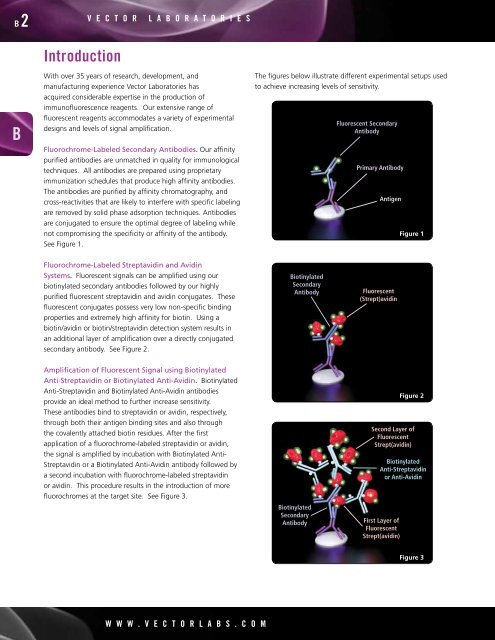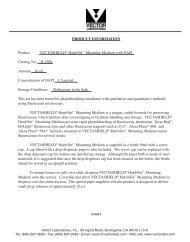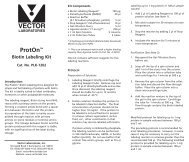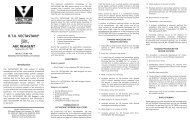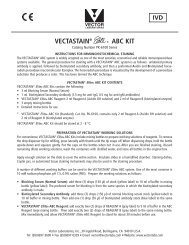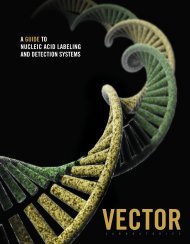VectorCatalog2012.pdf? - Vector Laboratories
VectorCatalog2012.pdf? - Vector Laboratories
VectorCatalog2012.pdf? - Vector Laboratories
You also want an ePaper? Increase the reach of your titles
YUMPU automatically turns print PDFs into web optimized ePapers that Google loves.
B<br />
B<br />
2<br />
Introduction<br />
V E C T O R L A B O R A T O R I E S<br />
With over 35 years of research, development, and<br />
manufacturing experience <strong>Vector</strong> <strong>Laboratories</strong> has<br />
acquired considerable expertise in the production of<br />
immunofluorescence reagents. Our extensive range of<br />
fluorescent reagents accommodates a variety of experimental<br />
designs and levels of signal amplification.<br />
Fluorochrome-Labeled Secondary Antibodies. Our affinity<br />
purified antibodies are unmatched in quality for immunological<br />
techniques. All antibodies are prepared using proprietary<br />
immunization schedules that produce high affinity antibodies.<br />
The antibodies are purified by affinity chromatography, and<br />
cross-reactivities that are likely to interfere with specific labeling<br />
are removed by solid phase adsorption techniques. Antibodies<br />
are conjugated to ensure the optimal degree of labeling while<br />
not compromising the specificity or affinity of the antibody.<br />
See Figure 1.<br />
Fluorochrome-Labeled Streptavidin and Avidin<br />
Systems. Fluorescent signals can be amplified using our<br />
biotinylated secondary antibodies followed by our highly<br />
purified fluorescent streptavidin and avidin conjugates. These<br />
fluorescent conjugates possess very low non-specific binding<br />
properties and extremely high affinity for biotin. Using a<br />
biotin/avidin or biotin/streptavidin detection system results in<br />
an additional layer of amplification over a directly conjugated<br />
secondary antibody. See Figure 2.<br />
Amplification of Fluorescent Signal using Biotinylated<br />
Anti-Streptavidin or Biotinylated Anti-Avidin. Biotinylated<br />
Anti-Streptavidin and Biotinylated Anti-Avidin antibodies<br />
provide an ideal method to further increase sensitivity.<br />
These antibodies bind to streptavidin or avidin, respectively,<br />
through both their antigen binding sites and also through<br />
the covalently attached biotin residues. After the first<br />
application of a fluorochrome-labeled streptavidin or avidin,<br />
the signal is amplified by incubation with Biotinylated Anti-<br />
Streptavidin or a Biotinylated Anti-Avidin antibody followed by<br />
a second incubation with fluorochrome-labeled streptavidin<br />
or avidin. This procedure results in the introduction of more<br />
fluorochromes at the target site. See Figure 3.<br />
w w w . V E C T O R L A B S . C O m<br />
The figures below illustrate different experimental setups used<br />
to achieve increasing levels of sensitivity.<br />
Biotinylated<br />
Secondary<br />
Antibody<br />
Biotinylated<br />
Secondary<br />
Antibody<br />
Fluorescent Secondary<br />
Antibody<br />
Primary Antibody<br />
Antigen<br />
Fluorescent<br />
(Strept)avidin<br />
Figure 1<br />
Figure 2<br />
Second Layer of<br />
Fluorescent<br />
Strept(avidin)<br />
Biotinylated<br />
Anti-Streptavidin<br />
or Anti-Avidin<br />
First Layer of<br />
Fluorescent<br />
Strept(avidin)<br />
Figure 3


